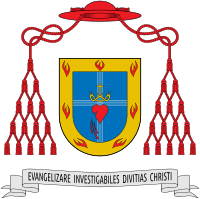Leo Scheffczyk
| His Eminence Leo Scheffczyck | |
|---|---|
| Appointed | 21 February 2001 |
| Other posts | Cardinal-Deacon of San Francesco Saverio alla Garbatella |
| Orders | |
| Ordination | 29 June 1947 |
| Created Cardinal |
21 February 2001 by Pope John Paul II |
| Rank | Cardinal-Priest |
| Personal details | |
| Birth name | Leo Scheffczyk |
| Born |
21 February 1920 Beuthen, Germany |
| Died |
8 December 2005 Munich, Germany |
| Nationality | German |
| Denomination | Roman Catholic |
| Motto | Evangelizare investigabiles divitias Christi |
| Coat of arms |
 |

Leo Scheffczyk (21 February 1920, in Beuthen O.S. – 8 December 2005, in Munich) was a German cardinal and theologian. He was a long-time theologian at the Congregation for the Doctrine of the Faith and one of the strongest advocates for orthodoxy during the long pontificate of John Paul II. During the 1980s and 1990s, he severely criticized some of his former students, e.g. Leonardo Boff, who advocated a Marxist version of liberation theology. Scheffczyk likely played a major role in drafting the most controversial documents, such as Ordinatio Sacerdotalis and Ad Tuendam Fidem.[1] He was made a cardinal in 2001. He was regarded as an important thinker in late twentieth-century Catholicism.
Life and career
He was born in the city of Beuthen, today Bytom, Poland. He studied during World War II at the famous theological department of the University of Breslau. He moved afterwards to the University of Munich. Scheffczyk was ordained as a priest for the Archdiocese of Munich on 29 June 1947.
Immediately, Scheffczyk took to theological work and within a year of his ordination he was already a Theology professor at the seminary in Königstein im Taunus. He later moved to the more prestigious university at Tübingen. During that time his theological knowledge was already immensely appreciated by his students, including such notables as Walter Kasper. Whilst he was immensely knowledgeable on such subjects as the Virgin Mary, Scheffczyk was not then considered a likely choice for a promotion into the papal curia. Unlike such theologians as Yves Congar, he remained remote from the proceedings of Vatican II, though he undoubtedly understood its thought very well.
His return to the University of Munich in 1965 coincided with long periods of writing on various theological topics.
After 1978, Scheffczyk became a monsignor. Though still focusing on writing theology, he did an increasing amount of work in the Congregation for the Doctrine of the Faith, often being consulted by Ratzinger as the Congregation devoted itself to settling theological questions. However, Scheffczyk never apparently had any desire to become a public figure.[2]
Cardinal
John Paul II, responding to requests by Cardinal Ratzinger[3] and by Avery Dulles, appointed Scheffczyk a cardinal on 21 February 2001, becoming Cardinal-Deacon of San Francesco Saverio alla Garbatella. Considering his age, Scheffczyk asked for dispensation not to be consecrated a bishop (as required by modern canonical law).
Mariology
Scheffczyk was an enyclopedic mariologist; co-editor and major contributor to Marienlexikon,[4] which includes mariological studies on some 4000 pages. In his article on mariology during Vatican II, he opined, that in the justified search for unity among Christians, Marian beliefs and devotions were understated by some representatives of the Roman Catholic Church, starting with the Vatican II document Lumen gentium, the Marian chapter: "The coldness and reserve of this document can be explained, as it is openly admitted, in showing consideration for the ecumenical dialogues especially with Protestants. The success of this justifiable method, should not be overrated. And it does not stop theology to say more."[5] He disagrees with those who consider the document as not satisfying conservatives, liberals, Orthodox and Protestants, stating that the document contains visible elements for a mariological bridging of positions, a bridging, which he concludes has so far not succeeded.[5] He regretted, however, that:
The decisive basic statements (on Mary) are compromises, which narrow the richness of the existing faith and invite diverging interpretations, such as the accusation, the Council eliminated the Mediatrix teachings.[6]
Notes
- ↑ Allen, John L. (Jr.); Cardinal Ratzinger: The Vatican's Enforcer of the Faith; page 186; published 2000 by Continuum International Publishing Group
- ↑ Allen, p. 45-47.
- ↑ Extract from November 2006 interview with Pope Benedict XVI, on the web here.
- ↑ Remigius Bäumer, Leo Scheffczyk (Hrsg.): Marienlexikon Gesamtausgabe, Institutum Marianum Regensburg, 1994, ISBN 3-88096-891-8
- 1 2 Leo Cardinal Scheffczyk, Vaticanum II, in Marienlexikon, 571
- ↑ Leo Cardinal Scheffczyk, Vaticanum II, in Marienlexikon,570
